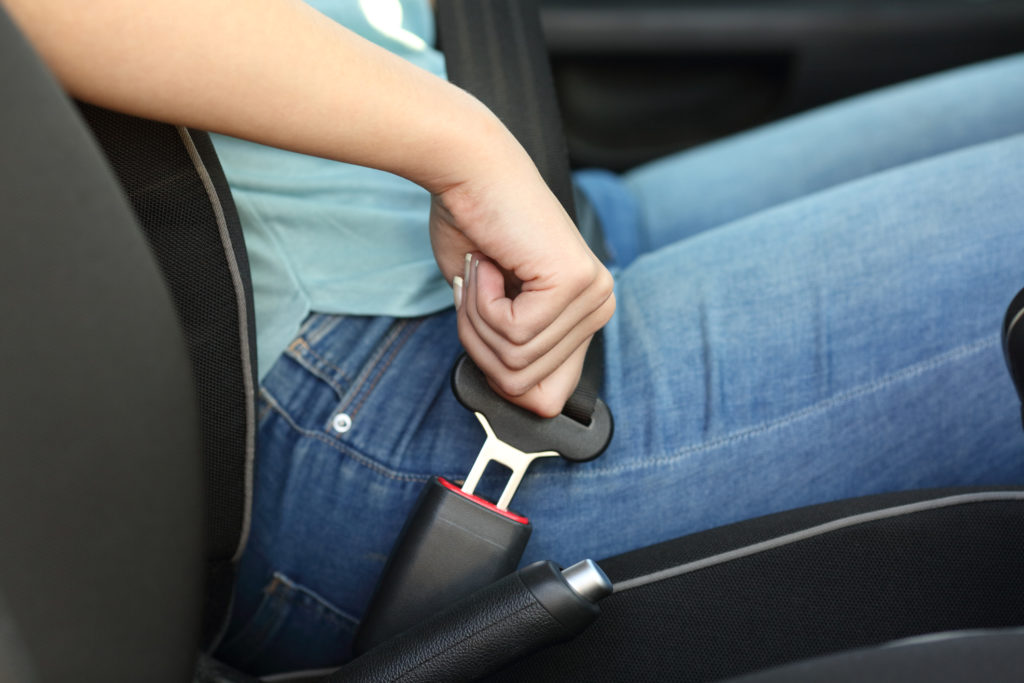DON’T FORGET TO BUCKLE UP!

What’s the first thing you do when you settle into the front seat of your car? Do you turn on your radio, or perhaps adjust the rearview mirror? Maybe you program your GPS or make sure your Bluetooth is connected. But the first thing you should do is a simple step that could save your life: buckle your seatbelt.
In 2016, more than 37,400 people were killed in motor vehicle crashes – 48 percent of those individuals were not wearing seat belts. While the national seat belt use rate is 90.1 percent, nearly 27.5 million Americans still don’t wear a seatbelt. Taking that risk sets you up for a potentially life-ending or life-changing event. In an unbelted crash, your head is likely to hit the steering wheel or windshield, or you could be ejected from the vehicle. If you survive, you could have brain and spinal cord injuries that take years and millions of dollars to recover from, if ever.
Taking three to four seconds to fasten that seatbelt to help save your life. Here’s what you need to know about buckling up:
Buckling up is the single most effective thing you can do to protect yourself in a crash.
Seatbelts are the best defense against impaired, aggressive, and distracted drivers. Being buckled up during a crash helps keep you safe and secure inside your car. The consequences of being ejected from your car in a crash are irreversible.
Air bags are designed to work with seat belts, not replace them.
Air bags alone are not enough to protect you; in fact, the force of an air bag can seriously injure or even kill you if you’re not buckled up. Seatbelts work in tandem with air bags to protect you in a crash.
Wear your seatbelt correctly.
Never improvise with your seatbelt. Moving the shoulder strap below your arm, or putting behind your back, puts you at great risk in a crash. Don’t loosen the lap belt to make yourself more comfortable. The lap belt and shoulder belt should be firmly secured across the pelvis and rib cage, which are better able to withstand crash forces than other parts of your body. The shoulder belt should go across the middle of your chest and away from your neck. The lap belt should cross your hips, not your stomach. Sit up straight in your seat as slouching will affect how the seat belt restrains you.
Fit matters.
When you’re test driving a new car, check to see that its seatbelts are a good fit for you. Ask about seatbelt adjusters which can help you get the correct fit. If you need a larger seatbelt, contact the vehicle manufacturer to purchase seat belt extenders.
If you’re pregnant, you still need to wear a seatbelt.
Throughout your entire pregnancy you should wear your seatbelt to protect yourself and your unborn child. Make sure you know how to position your seat and seatbelt by reviewing this instructional flier from the National Highway Transportation Safety Administration on how to wear a seatbelt when you’re pregnant.
Make sure your children under age 2 travel in a car seat that has been installed and inspected for safety.
Under California law, children under 2 years of age must ride in a rear-facing car seat unless the child weighs 40 or more pounds OR is 40 or more inches tall. It is actually five times safer for children to ride in rear facing car seats – instead of flying forward in a crash, their head, neck and back will be supported by the car seat. Find car seat information as well as a car seat inspection location near you from the National Highway Traffic Safety Administration.
Know when your child is ready to leave the booster seat behind and start using an adult seatbelt.
It’s another California law that all children under 8 must be in a car or booster seat unless they’re at least 4 feet, 9 inches tall. At that height, kids can legally escape their booster seat but since it’s safer, we recommend keeping them in the booster seat as long as possible. This means they need to meet the maximum weight or height as specified by the manufacturer.
Model seatbelt safety.
Last but not least, you as a parent are your kids’ strongest influence when it comes to modeling safe driving practices – this includes buckling up every time you get in the car.

